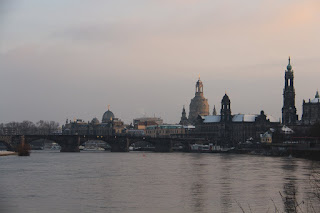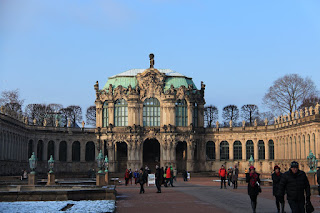Actually, more or less all I knew about Dresden was from studying history back at university. Of course the images of the burning city as a sad example of what happened to so many european cities during the second World War have stuck in my mind ever since I first saw them. But other than that I did not know much about Dresden. Monsieur has lived there for about a year when he was a student, but had not been there for a while, and he was curious to see what had changed.
Well, first of all it was very, very cold and later even started to snow. Not the ideal weather for sightseeing, but then again there are a lot of things to see and to do indoors, and many nice cafés to get warm again after wandering around. I particularly recommend CAMONDAS, a café which has an exceptional selection of chocolate (it's a chocolate shop, really). Loved it!
 |
| The Zwinger |
Of course we visited the main sightseeing spots. In winter, the gardens of the Zwinger (pictures above) are not as attractive as they probably are in spring or summer, so we didn't spend much time there. The neighbouring Residenzschloss is home to the famous "Grünes Gewölbe" (green vault), the name is a bit misleading as there are actually two green vaults, a historical and a new one. August the strong, elector of Saxony in the early 18th century, wanted to have a safe place for his collected treasuries, and so the historical vault was constructed. August did not just wish to keep his treasures safe, but he also wanted to show them to special visitors, so they were arranged in a series of decorated rooms. Very impressive! It's not allowed to take pictures inside, but you can take a virtual tour here.
 |
| The "Fürstenzug", a mosaic showing ancient rulers of the city. |
The new green vault shows the parts of the collection which did not find their place in the historical rooms, and is open to the public since 2004. The restauration of the historical rooms has taken a long time and they are open again since 2006. The virtual tour of the new grünes Gewölbe can be found here. I really liked it and could have spent much more time in there - so many things to see, little details and incredible things like a cherry stone with 185 faces carved into its surface!
February 1945, six months after the first allied bombs fell on Dresden, three nights of heavy bombings destroyed 60 percent of the city and killed more than 20000 inhabitants. Many of Dresden's cultural treasures were destroyed, among them the Residenzschloss with the green vault, the opera and the Frauenkirche (Church of Our Lady). The reconstruction of Dresden took decades and while the opera and other buildings like the Zwinger have been rebuilt before the German unification, the Frauenkirche was left in its ruined appearance until 1994.
The people of Dresden would have liked to have it reconstructed right at the end of the war, but by then the city was occupied by the soviets. Later it became part of the German Democratic Republic, and the reconstruction was not concluded due to political circumstances. Instead, the ruin became a war memorial, a counterpart for Coventry cathedral in the UK. A huge fundraising campaign started in the late 1980s and donors from all over the world, especially from the UK and USA, helped collecting the huge sum of 180 million Euro needed for the reconstruction which was finally concluded in 2005.
 |
| You can see that original material has been used to reconstruct the Frauenkirche. |
I have been to other places where the consequences of World War II still are very tangible, I have visited Coventry cathedral and Omaha Beach, for example. Few of these places have impressed me the way the Frauenkirche did. It is a humbling experience to stand in this church. It was destroyed shortly before the end of the war - many historians doubt that the bomb raids on Dresden really could be justified the way the allied forces did, as mainly cultural spots have been hit while bridges or other buildings more vital for Nazi communication etc. have not been affected. Very often when talking about World War II, the German victims, especially the people in the cities hit by the allied raids, are not mentioned. Dresden is an important reminder that war ultimately claims innocent victims on all sides.
In the church today there's an exposition showing the history of the Frauenkirche including the destruction and reconstruction. There are a lot of anecdotes to read about the people involved, and probably the most touching is the story of the cross on top of the church's dome. It was forged in London and designed by a goldsmith whose father had taken part in the bombings of Dresden as a crew member of one of the airplanes.
 |
| The Semperoper. |
Gottfried Semper was the name of the architect who designed the original building. It opened its doors in 1841. In 1869, a fire destroyed much of the opera, it was rebuilt in the following years, again based on a design by Semper. Gottfried Semper himself could not supervise the work himself, as he was exiled at the time (he'd been involved in the May 1849 uprising), so his son built the new opera. The second opera building opened in 1878. In 1945, the opera was destroyed again - this time by the bomb raids. Again the opera house was rebuilt, and re-openend in 1985. Today it looks the same as before the war from the outside. An interesting detail the guide told us about is that after the war, they wanted to rebuild the opera exactly the way it has been built in the 19th century. But especially when it came to decorations on the inside, this was harder than they had thought. For example the columns looking like marble are actually artificial. The art of crafting artificial marble had been almost lost in the German Democratic Republic, so they had to train craftsmen. The guide said because of these circumstances and the long time it takes to make such a column, the columns were actually more expensive than they would have been if they had taken real marble!


In October 2014, a movement calling itself PEGIDA (Patriotische Europäer gegen die Islamisierung des Abendlandes, Patriotic Europeans against Islamisation of the Occident) started organising marches in Dresden on Monday evenings. Every week, thousands came and listened to PEGIDA leaders telling them how dangerous muslim migrants are for European culture. Honestly, I don't know how it's possible that so many are frustrated enough to actually look for this kind of affirmation. I think movements like PEGIDA are dangerous and every liberal and open minded European knowing our continent's history has to stand up and rais their voices against such hatred. Especially in Dresden, especially on Monday evenings. In 1989 and 1990, Monday evening used to be the time when people in the cities of the German Democratic Republic used to demonstrate, in peace, demanding rights such as the freedom of travel. They used to chant "Wir sind das Volk!" (we are the people) - and, ironically, that's what the PEGIDA people now chant as well, historical amnesia at its best. These developments bothered me one year ago when we visited Dresden, and they still do, as Europe faces the huge challenge of welcoming refugees from Syria and other countries torn by war and economical crisis. It's always great to see that there's not only hatred, not only negative feelings, but also people who are very aware of Europe's history and why it's so important not to forget about it right now. In Dresden this awareness was very present one year ago. For example, on the square in front of the Semperoper, the exact place where the PEGIDA demonstrations take place, huge flags were flying showing the opera's official opinion:
It says "Die Würde des Menschen ist unantastbar - Türen auf - Herzen auf - Augen auf", which means "Human dignity is inviolable - Open doors - Open hearts - Open eyes". There's hope, apparently.
We also used the days we had in Dresden to go shopping. I liked the many independent shops in the Neustadt, it's a lively and interesting part of the city with lots of cafés we visited. We loved the Baumstriezel Manufaktur. It's a small place, but with a great atmosphere and - as promised by the name - they serve handmade Baumstriezel. I didn't even know what a Baumstriezel is before we discovered the café. On their website you can see how the sweets are made - it's really nice.
One very special building we visited is the Yenidze. It definitely doesn't look like a building you'd expect in a German city - more like an oriental mosque, including a huge dome and minarets. But why?
In 1886, Hugo Zietz founded his tobacco factory in Dresden, it was called Yenidze from the beginning because the tobacco he used came from the region around Yenidze (today Giannitsa in Greece). In 1907, Zietz wanted to have his new factory building in Dresden, but at the time it was forbidden to build factories which looked like factories. A building that looked like a mosque definitely did fulfill this requirement - and of course it served as a wonderful publicity medium for the Yenidze products! Today there's a restaurant in the dome of the building. We went there to have lunch and it was a wonderful experience!
After having spend a few days in Dresden, we went back to Berlin. But on the way there, we met Monsieur's grandparents in Moritzburg. Moritzburg itself is not a famous place - or do you know why you should visit? I didn't, actually, until I saw the castle - and immediately recognised it. Of course. I had seen it many, many times on TV. Moritzburg Castle has been the film location for "Three Wishes for Cinderella", a film from 1973. Every year around Christmas, TV stations show it again, at least in German-speaking countries. So I kind of grew up connecting Moritzburg Castle to Christmas time. Seeing it in winter - like in the film! - was really nice, although I'm sure it's just as beautiful in summer.
I don't know if I would have visited Dresden or Moritzburg without having a reason to go there like seeing Monsieur's family, but it was really worth a trip! I love to travel to places I don't choose for myself. The chance to discover new corners of the world, most of them beautiful and absolutely worth seeing - that's what I love about accepting invitations from friends who live somewhere else (or even business trips, for that matter =)



















No comments:
Post a Comment